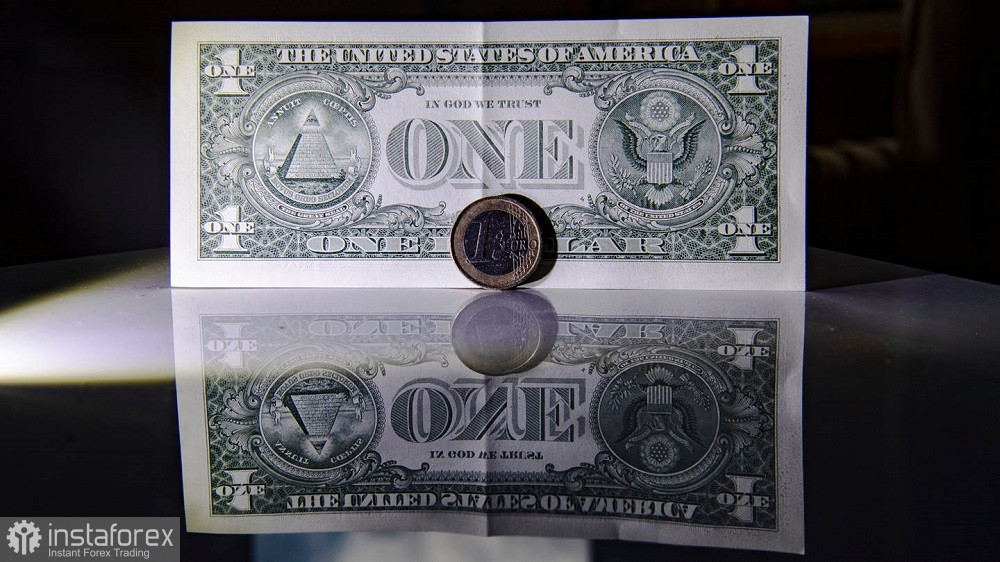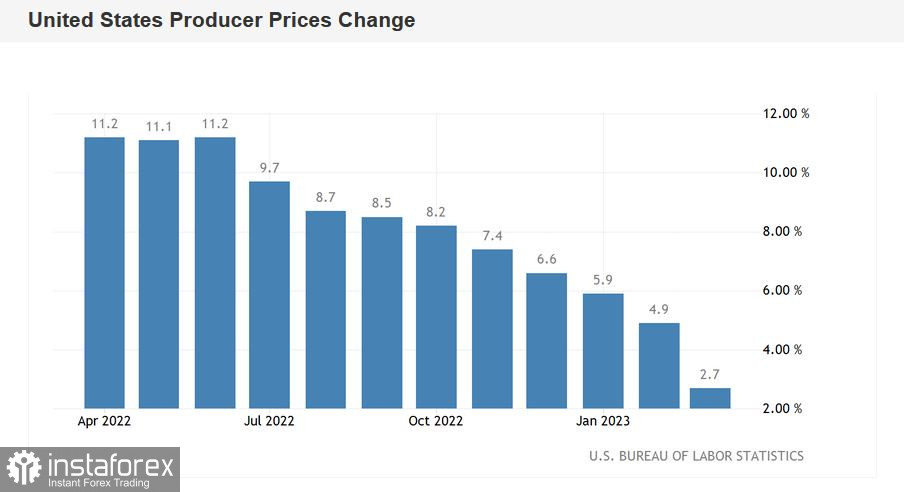On Thursday, the EUR/USD pair overcame the resistance level of 1.1030, which corresponds to the upper line of the Bollinger Bands indicator on the daily chart. The price has updated the annual high (1.1034), which was set in early February. The pair is moving towards the 1.11th figure as a result of the previous momentum, when the dollar fell across the market on Wednesday, reacting to the Consumer Price Index. Another inflation report was published in the US, which provided more support to the bulls. This is the Producer Price Index, which came out in the "red", reflecting the slowdown of US inflation.
The "red hue" of the PPI
So, the PPI disappointed the dollar bulls again. The index came out at 2.7% in annual terms, versus an estimate of a 3.0% decline. This is the weakest growth rate since January 2021. The indicator has been consistently declining for nine straight months. The core PPI, excluding food and energy prices, also fell significantly, reaching 3.4% (the weakest growth rate since March 2021). This component of the report has been declining since April last year.

It is noteworthy that, following the two inflation reports, the probability of a rate hike at the May meeting has only increased, despite the significant drop in the CPI and PPI. According to data from the CME Group FedWatch Tool, there's a 66% chance of a quarter point rate hike in May. This is because core inflation has accelerated. The core CPI, excluding food and energy prices, rose to 5.6% in annual terms. Meanwhile, the core index had been consistently declining for the last five months. This fact has led to the assumption that the Federal Reserve will be forced to raise the rate once again, possibly at the next meeting. As a reminder, the Fed's updated median forecast also assumes one more rate hike in 2023.
But all these hawkish circumstances, as they say, light up but do not fuel the dollar bulls. Despite the growth of hawkish expectations, the dollar continues to plunge across the market.
Is the Fed ready to take a step back?
In my opinion, this situation is related to the growing dovish expectations in the long term. Rumors that the Fed will lower the rate closer to the end of the current year are being circulated more and more recently. And after the recent statement by the New York Fed Chief John Williams (who has a permanent voting right in the Committee and is considered one of the most influential Fed officials), these rumors have gained practical significance.
In an interview with Reuters, Williams said that if inflation decreases, then "the Federal Reserve will have to lower rates." At the same time, he acknowledged that the central bank is likely to raise the rate again in May, as the Bank "needs to see a decrease in core inflation." However, the market focused its attention on the dovish aspects of his speech. In fact, Williams admitted the realization of such a scenario within the current year.
I would like to remind you that after the March meeting, Fed Chairman Jerome Powell also did not deny such a development of events. He diplomatically noted that this scenario "is not the base case."
Conclusions
The US dollar index continues to plunge, reacting to the decline in inflation indicators. Following the CPI, the PPI also came out in the red. Prior to this, the core PCE index also demonstrated a downtrend.

Inflation in the US is slowing down, and this is putting pressure on the greenback, even despite a slight acceleration in the core CPI index. Overall, in my opinion, the market has come to several conclusions: 1) in May, the Fed will likely go for another quarter point rate hike ; 2) this will be the last in this cycle of monetary tightening; 3) if the current pace of declining inflation indicators persists, the Fed will, in a few months, update the discussion on lowering the rate (Williams brought this up the other day, admitting the realization of a dovish scenario).
All these conclusions are on the side of the EUR/USD bulls.
The technical picture for the pair shows similar signals. On all higher charts (from H4 and above), the pair is either at the top or between the middle and top lines of the Bollinger Bands indicator. In addition, on the daily chart, the Ichimoku indicator has formed one of its strongest bullish signals - the "Parade of Lines". Therefore, it would be wise to use any corrective pullbacks to open long positions – with the first, and for now, the main price target of 1.1100.
 English
English 
 Русский
Русский Bahasa Indonesia
Bahasa Indonesia Bahasa Malay
Bahasa Malay ไทย
ไทย Español
Español Deutsch
Deutsch Български
Български Français
Français Tiếng Việt
Tiếng Việt 中文
中文 বাংলা
বাংলা हिन्दी
हिन्दी Čeština
Čeština Українська
Українська Română
Română

